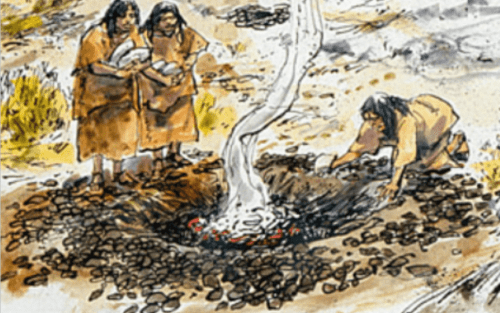
I wonder how often we pass by the remains of ancient civilizations, maybe even on our own land, without noticing anything is there? It could be that all that is left from a people lost to history is a few piles of burnt stones, like the ones found at Camp Bowie. The charred rocks surround very old kitchen middens, basically inground ovens, that were built by an unknown people over 1,000 years ago.
Because Camp Bowie was owned and built by the government, certain rules for archiving and investigating any potential archeological sites on the land were in play. To fulfill these guidelines, the kitchen middens which dotted the landscape out at Camp Bowie, and are also found across West Central Texas, were investigated and results recorded by researchers intent on discovering the actual purpose of the middens. It seems the structures employed heated rocks and a fairly complicated methodology used to slow cook certain foods.
The use of heated rocks in cooking is not unique to the midden sites in Texas. People have used the technique across the world, for countless centuries. Basically, a large hole several feet both deep and wide was dug. Rocks were layered at the bottom of the hole, then grasses were piled between the rocks and the food that needed cooking, both to protect the food and to create steam. The final step was to place a layer of dirt over the whole apparatus, thus allowing heat to be maintained within the oven for up to 48 hours. Oddly, this is not unlike some processes I’ve seen for making barbecue in Texas, but I digress. Anyway, the cooking rocks would eventually crack in the heat. Broken rocks were discarded in a sort of ring around the fireplace, and new rocks were added in as needed. Over time, the piles of discarded rock surrounding the pit made the sites of these old time chefs easily identifiable.
According to an article published by the Texas Beyond History website, 19 rock kitchens at Camp Bowie were evaluated by the Center for Archeological Research at the University of Texas in order to determine what was cooking out there a millennium ago. While the archeological work on the middens in our area was first undertaken by Professor James Pearce from the University of Texas in 1917, recent developments in technology and information gathering made it worthwhile for another team to visit the Camp Bowie sites in the 1990s. The article records some of the finds made, including flint tools, and details conclusions drawn from the work that might help us to gain a better understanding of why people would build a large amount of these fairly labor-intensive cooking pits throughout the rolling plains of Texas.
The researchers discovered, based on remains found on the cooking rocks, that our earliest unknown settlers were cooking different types of bulbs: “In the Camp Bowie area, the most likely candidates are geophytes, herbaceous plants with underground storage organs (bulbs), such as wild onions, that require long-term baking to make the plant digestible. There are several different kinds of geophytes with various types of storage organs (bulbs, tubers, etc.).”
I have to admit I was hoping for something more dramatic, like roasting wooly mammoths in the true Texas deep pit style instead of onions. Nevertheless, it is fascinating to think about what this sort of life may have been like, where these people might have come from and where they went. Were they part of an established tribe in some other location that came out here regularly to hunt up their bulbs, bake them up and carry them back to another location? Did they come from Mexico or down from the northern plains? Did they settle here along the banks of Pecan Bayou, or only pass through regularly on scouting trips? These people would have been on foot, they would have struggled through the brush and snakes, stopping to find what they needed for survival, digging and laboring in the hot sun to build their middens and then renewing these old sites over and over for years untold. Did they construct the rock cairn burial sites also found throughout our area? What did they have to say about where they came from, what was important to them? I guess we’ll never know.
Kitchen middens, like those found at Camp Bowie, were also recorded in older historical accounts of the area, and it is said they once lined Pecan Bayou for miles. Most of these sites have disappeared due to construction and the plow. You can, however, with a sharp eye, pick out likely sites while driving through the area, watching for telltale piles of rocks that have burn marks. There are still quite a few out there.
***
Diane Adams is a local journalist whose columns appear Thursdays on BrownwoodNews.com
